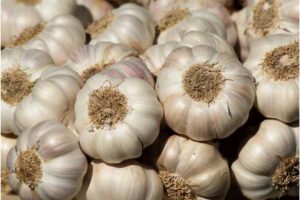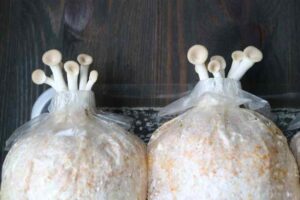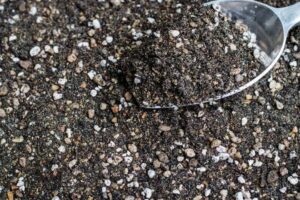
Garlic is an incredibly versatile and easy-to-grow crop. Planting garlic in Maine is no exception, as it can thrive in the state’s mild climate. Whether you’re a beginner gardener or a seasoned pro, planting garlic in Maine is a great way to add flavor to your meals and improve your garden’s soil quality.
However, in Maine, the optimal time to plant garlic is in the fall, typically between Columbus Day and Halloween. To successfully plant garlic, gardeners should choose cold-hardy garlic varieties, prepare the soil by incorporating compost or well-rotted manure for fertility, plant cloves 2 inches deep and 6 inches apart, and choose a location with full sun exposure. During the winter, a layer of mulch can protect the garlic. The result is a rewarding summer harvest of this kitchen staple.
With a few tips and tricks, you can easily grow a large harvest of garlic in Maine.In this guide, we’ll cover everything you need to know about planting garlic in Maine, from selecting the best varieties to harvesting your crop.
Selecting Garlic Varieties for Maine
Selecting garlic varieties to grow in Maine can depend on many factors such as the specific climate, soil type, and the individual grower’s preferences. Here are some garlic varieties that are well-suited to the conditions in Maine:
- German Extra Hardy: Also known as Northern White, this variety of hardneck garlic is well-suited to cold winters and has a robust and spicy flavor.
- Music: A popular variety, Music garlic is a hardneck type that’s known for its high yield and large, easy-to-peel cloves. It’s also known for its rich, robust flavor.
- Russian Red: This is a reliable hardneck variety that is very cold-hardy, making it suitable for Maine’s cold winters. It’s known for its strong, hot flavor.
- Spanish Roja: Another hardneck variety, Spanish Roja is favored by many for its true garlic flavor and is often described as the most flavorful garlic.
- Inchelium Red: This is a softneck garlic variety that stores well and can handle cold temperatures. It has a milder flavor that gets stronger as it stores.
- Chesnok Red: A beautiful hardneck variety that is superb for cooking and very cold hardy. It’s a great all-purpose garlic and does well in a variety of climates.
- Siberian: This variety has one of the highest allicin contents, a compound that makes garlic good for your health. It’s also a very hardy variety that does well in cold climates like Maine.
When preparing to plant garlic in Maine, it’s best to plant in the fall, allowing the bulbs to overwinter and produce a crop the following summer.
Before planting, prepare your soil by ensuring it’s well-drained and add compost to increase fertility. Plant the cloves pointy-end up, about 2 inches deep and 6 inches apart.
Remember that garlic likes full sun, so select a spot in your garden where it will receive plenty of daylight.
Finally, different varieties of garlic have different flavor profiles, so it’s important to select a variety that you or your customers will enjoy. With these considerations in mind, you can select the perfect garlic varieties for Maine.
Preparing the Soil for Planting Garlic
Garlic is an incredibly versatile ingredient, and growing it yourself can be a rewarding experience. Planting garlic, however, starts long before you set cloves into the soil. Preparing the soil is a key step in ensuring a successful harvest. Have a look.
Step 1: Choose the Right Spot:
Garlic prefers a spot that receives full sun with soil that drains well. If the soil is too wet, the garlic may rot.
Step 2: Soil Testing:
Before planting, test your soil to check its pH and nutrient levels. Garlic prefers a pH between 6.0 and 7.0. If your soil’s pH is too low, you can add lime to raise it, and if it’s too high, you can add sulfur to lower it.
Step 3: Clear the Area:
Remove any rocks, roots, or weeds from the planting area. These can inhibit the growth of the garlic.
Step 4: Improve the Soil:
Add organic matter to your soil to improve its structure and fertility. Well-rotted compost or manure are good options. This step is crucial as garlic has high nutrient needs.
Step 5: Till the Soil:
Use a garden fork or tiller to loosen the soil to a depth of at least 12 inches. This allows the garlic roots to penetrate the soil more easily.
Step 6: Level the Ground:
Smooth out the surface of the soil with a rake. This prepares the area for planting.
Step 7: Nutrient Addition:
Based on your soil test, you might need to add nutrients. Garlic especially needs a good amount of nitrogen. Incorporate a balanced fertilizer into the soil if necessary.
Step 8: Wait for the Right Time:
Once the soil is prepared, wait until the right time to plant. In Maine, this is usually between Columbus Day and Halloween.
Preparing the soil correctly is a crucial step in successfully growing garlic. It not only provides the necessary nutrients for the garlic to grow but also improves the structure and drainage of the soil.
Planting Garlic Bulbs in Maine
- Acquire Quality Bulbs: Start by purchasing high-quality garlic bulbs from a local nursery or a reputable online source. Choose cold-hardy varieties suitable for Maine’s climate, such as German Extra Hardy, Music, Russian Red, or Siberian.
- Separate the Cloves: Break apart the garlic bulbs into individual cloves right before you’re ready to plant. Be careful not to damage the cloves, and ensure you keep the papery husk on each one.
- Prepare the Soil: As discussed previously, prepare your soil well in advance of planting. The soil should be well-draining and rich in organic matter. The pH should be between 6.0 and 7.0.
- Dig Holes: Dig holes in the soil about 2 inches deep and 6 inches apart. If you’re planting multiple rows of garlic, the rows should be about 12 inches apart.
- Plant the Garlic: Plant each clove with the pointed end facing up and the flat end facing down. The pointed end is where the sprout will emerge, and the flat end is where the roots will grow.
- Cover the Cloves: After all the cloves are planted, cover them with soil and then add about 4-6 inches of organic mulch, such as straw, hay, or shredded leaves, on top. This layer of mulch will help insulate the garlic over the winter and help retain moisture.
- Winter Care: In Maine, the ground will freeze over winter, which is what the garlic needs to go dormant and then sprout in the spring.
- Spring Emergence: Come spring, shoots will emerge from the ground. At this point, you can pull back the mulch a bit to let the shoots see the sun. Keep the soil moist but not waterlogged.
- Harvest Time: Garlic is typically ready for harvest in mid-summer when the bottom leaves start to brown. You’ll know it’s time to harvest when about half of the leaves have died back.
More or less, patience is key when growing garlic. After planting in the fall, it won’t be ready for harvest until the following summer. But with proper care and attention, you’ll be rewarded with a bountiful harvest of fresh, homegrown garlic.
Caring for Garlic Plants in Maine
Garlic plants need plenty of sun and water and should be planted in well-draining soil with plenty of organic matter. They should be spaced at least 4-6 inches apart to ensure good air circulation. To enhance flavor, wait until the leaves start to yellow before harvesting.
During the winter, mulch the garlic plants to protect them from the cold and ensure they stay healthy. With a little bit of care, you can enjoy homegrown garlic in Maine all year round!
- Watering: Garlic plants need consistent watering. The soil should be moist but not waterlogged. Overwatering can cause the bulbs to rot.
- Weeding: Keep the garlic bed free of weeds. Weeds compete with garlic for nutrients and water. Mulch can help suppress weed growth and maintain soil moisture.
- Fertilization: Garlic plants appreciate a boost of high-nitrogen fertilizer in the spring when they begin active growth.
- Mulching: Maintain a layer of organic mulch around the garlic plants to help retain soil moisture, suppress weed growth, and keep the soil temperature more stable.
- Scaping: If you’re growing hard-neck varieties, they will produce a flower stalk, or “scape”, in late spring or early summer. It’s typically recommended to remove the scape so the plant can direct more energy into bulb growth.
- Pest and Disease Management: Monitor your garlic plants for signs of pests or disease. Garlic can be susceptible to problems like white rot, garlic bloat nematode, and leek moth.
- Harvesting: Harvest garlic in mid-summer when the bottom half of the leaves has turned yellow or brown.
- Curing: After harvesting, cure the garlic by hanging it in a dry, well-ventilated area out of direct sunlight for a few weeks. This process allows the garlic to dry out and improves its storage longevity.
- Storing: Once cured, store garlic in a cool, dry place. Properly stored garlic can last for several months.
Harvesting Garlic in Maine
Harvesting garlic in Maine generally takes place in mid-summer, typically in July or early August. Here’s how to do it:
Step 1: Timing
The right time to harvest garlic is when about half or two-thirds of the leaves have turned yellow or brown. Each green leaf represents a layer of protective wrapping around the bulb, so if you wait until all the leaves have died back, the bulb may not be well protected and could decay in storage.
Step 2: Dig, Don’t Pull
Use a garden fork or spade to loosen the soil around the bulb gently. Avoid pulling the garlic up by the stem, as this could break off, leaving the bulb in the ground.
Step 3: Handle with Care
Freshly harvested garlic bulbs can bruise easily, so handle them with care. Avoid throwing or dropping the bulbs.
Step 4: Curing
Once harvested, the garlic needs to be cured for several weeks. Lay the garlic out in a single layer in a well-ventilated, shady spot. You can also tie the garlic in bunches and hang it up to dry.
Step 5: Trimming
After the garlic has cured, you can trim the roots off the bottom of the bulb and cut the stalks down to about an inch above the bulb.
Step 6: Storage
Store the cured garlic in a cool, dry place. Garlic stored properly can last several months.
Step 7: Save Some for Planting
If you plan on planting garlic again, save some of your largest, healthiest bulbs. These can be broken into cloves and planted in the fall.
Remember, harvesting too early could result in smaller cloves while harvesting too late might lead to split bulbs that do not store well. So timing is crucial for harvesting garlic.
Storing Garlic in Maine
When garlic is grown in Maine, it needs to be stored in a cool, dry place to ensure it retains its flavor and freshness.
The ideal temperature is between 55-60°F, and the ideal humidity is between 60-70%. Keeping garlic in a controlled environment will also help it last longer, with a shelf life of several months.
The best way to store garlic in Maine is to hang it in a mesh bag in a well-ventilated area, such as a pantry or kitchen cupboard.
Garlic can also be stored in an airtight container in the refrigerator, but this should only be done for short periods of time as the cold temperature can cause it to spoil more quickly.
No matter how you choose to store your garlic, make sure to keep an eye on it and check for any signs of spoilage. Storing garlic in Maine will ensure it stays fresh and flavorful for the longest possible time.
FAQs About the How To Plant Garlic In Maine
What type of soil is best for planting garlic in Maine?
Answer: Garlic grows best in fertile, well-drained soil with a pH of 6.0-7.0. Adding organic matter such as compost or well-rotted manure is beneficial.
When is the best time of year to plant garlic in Maine?
Answer: Garlic should be planted in the fall, usually in late September or early October. Planting garlic in the fall allows the plants to develop a strong root system before winter.
How deep should I plant garlic cloves in Maine?
Answer: Plant cloves 1-2 inches deep and 4-6 inches apart. Make sure to plant the pointed end of the clove up and cover with soil. Water thoroughly.
Conclusion
Planting garlic in Maine can be an enjoyable and rewarding experience. With the right soil, sun and water, you can produce a delicious crop of garlic for years to come. To ensure success, it is important to choose the right variety of garlic for the region and to purchase quality seeds. Planting in the spring after the last frost and mulching heavily to protect the bulbs are essential steps for a successful crop. With proper care and attention, you can enjoy a plentiful harvest of garlic from your garden in Maine.








7 Comments